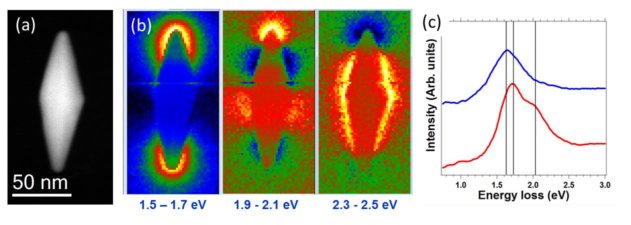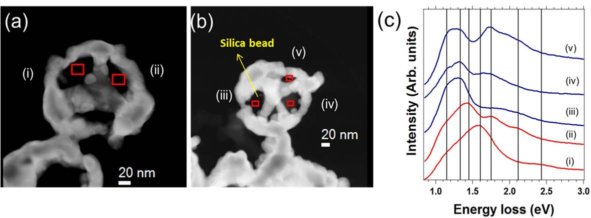IT-5-P-3210 Mapping SPR of Au metallic nano-objects with complex morphologies and environments
The remarkable optical properties of the metal nanoparticles(NPs), governed by the excitation of localized surface plasmon resonances (LSPRs), whose character and resonant energy depend on their size, shape, composition and environment, take nowadays a prominent position in research and applications. Imaging the LSPRs can be possible using various techniques such as scanning near optical microscopy(SNOM), photon electron emission microscopy(PEEM), electron energy loss spectroscopy(EELS)and photochemical imaging. Specifically,the EELS technique developed in the scanning(STEM) imaging mode of an electron microscope with a nanometer spatial resolution was often used for probing the SPR of metallic nanoparticles presenting classical morphologies such as spheres, cubes, rods, triangles.[1-3] Along this line the key-issue addressed by this work is the assessment of the optical response of the Au metallic NPs presenting more complex morphologies in presence of particular environments. The most important aspect on which we focused over the entire study relates on accessing information regarding, first the presence and the localization of the “hot spots” or areas as well as coupling effects between the LSPRs modes, and second the influence of the environment of Au NPs on the SPR modes. Regarding the effect of the NPs environment two aspects were closely investigated: the circular nature of the surface supporting the NPs and its dielectric environment.For the STEM-EELS experiments different systems with complex morphologies(see Fig.1) were considered: Au individual BP, Au assembled-BPs forming 2D clustered-structures; silica coated Au BPs;Au NPs presenting a patch morphology and silica beads casted inside the Au patches.At first, a close analysis of the monochromated EELS spectra recorded on a single Au NPs(see Fig.2) allowed identifying two main SPR centered at 1.5 and 2eV.This result helped us later in the analysis of the EELS spectra recorded when the more complex morphologies were studied. More exactly for the systems consisting of enchained Au BP we found that the presence of a neighbor NP induces slight modifications in the SP mode with respect to their position. For the other systems, the silica coated Au BP, Au patch and silica bead casted inside the Au patch the analysis of the plasmon spectra taken at different areas on the NP enabled us observing that the presence of the circular support as well as the dielectric environment are inducing energy shifts of some of the LPSR modes.
[1] J. Nelayah; et al., Nat. Phys.(2007)
[2] R. Arenal, Microsc. and Microanal.(2011)
[3] S. Mazzucco et al., Nano Lett.(2012)
The work was supported by the ANR under Grant no. ANR-BLANSIMI10-LS-100617-15-01. The research leading to these results has received funding from the European Union Seventh Framework Programme under Grant Agreement 312483 - ESTEEM2-I3.


